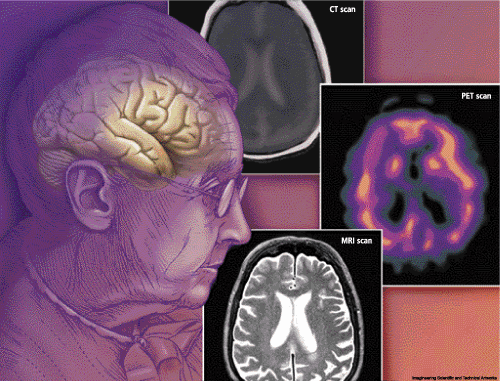Dementia is an organic brain syndrome which results in global cognitive impairments. Dementia can occur as a result of a variety of neurological diseases. Some of the more well known dementing diseases include Alzheimer’s disease (AD), multi-infarct dementia (MID), and Huntington’s disease (HD). Throughout this essay the emphasis will be placed on AD (also known as dementia of the Alzheimer’s type, and primary degenerative dementia), because statistically it is the most significant dementing disease occurring in over 50% of demented patients (see epidemiology). The clinical picture in dementia is very similar to delirium, except for the course. Delirium is an acute transitory disorder. By contrast Dementia is a long term progressive disorder (with the exception of the reversible dementias). The course of AD can range anywhere from 1.5 to 15 years with an average of about 8.1 years (Terry , 1988). AD is usually divided into three stages mild, moderate, and severe.
Throughout these stages a specific sequence of cognitive deterioration is observed (Lezak, 1993). The mild stage begins with memory, attention, speed dependent activities, and abstract reasoning dysfunction. Also mild language impairments begin to surface. In the moderate stage, language deficits such as aphasia and apraxia become prominent. Dysfluency, paraphasias, and bizzare word combinations are common midstage speech defects. In the severe stage the patient is gradually reduced to a vegetative state. Speech becomes nonfluent, repetitive, and largely non-communicative. Auditory comprehension is exceedingly limited, with many patients displaying partial or complete mutism. Late in the course of the disease many neuropsychological functions can no longer be measured. Also primitive reflexes such as grasp and suck emerge. Death usually results from a disease such as pneumonia which overwhelms the limited vegetative functions of the patient.
Dementia is commonly differentiated along two dimensions: age and cortical level. The first dimension, age, distinguishes between senile and presenile dementia. Senile dementia is used to describe patientswho become demented after the age of 65, whereas presenile dementia applies to patients who become demented prior to that age. Late onset AD (LOAD) also known as senile dementia Alzheimer’s type (SDAT) is the predominant cause of senile dementia. Early onset AD (EOAD) is the most frequent cause of presenile dementia, but HD, Pick’s disease and Creutzfeldt-Jakob disease though not as frequent are also important causes in presenile dementia.
The second dimension, cortical level, differentiates between cortical and subcortical dementia. Cortical dementia is used to describe dementia which results from brain lesions at the cortical level, whereas subcortical dementia describes dementia resulting from subcortical brain lesions. AD and Pick’s disease are the best known examples of cortical dementia; whereas HD, Parkinson’s disease (PD), and progressive supranuclear palsy (PSP) are good examples of subcortical dementia (Mayke, 1994). Dementia with both cortical and subcortical features is also possible, in that case the term mixed dementia is used. MID is a common example of mixed dementia.
Historical developments in dementia
The use of the term dementia dates back to Roman times. The Latin word demens did not originally have the specific connotation that it does today. It meant ‘being out of one’s mind’ and, as such, was a general term for insanity (Pitt, 1987). It was the encylopedist Celsus who first used the word dementia in his De re medicina, published around AD 30. A century later the Cappadocian physician Aretaeus first described senile dementia with the word dotage (i.e., “The dotage which is the calamity of old age…dotage commencing with old age never intermits, but accompanies the patient until death.”). Curiously, dementia was mentioned in most systems of psychiatric classification throughout pre-modern times, though the precise meaning of the word is often unclear (Pitt, 1987).

Thank you so much! This really helped me with my project; I am struggling in highschool! Bye for now! tehee XD